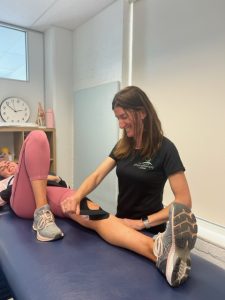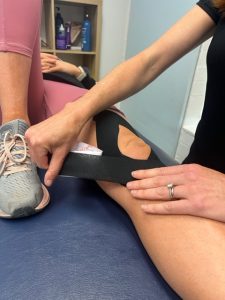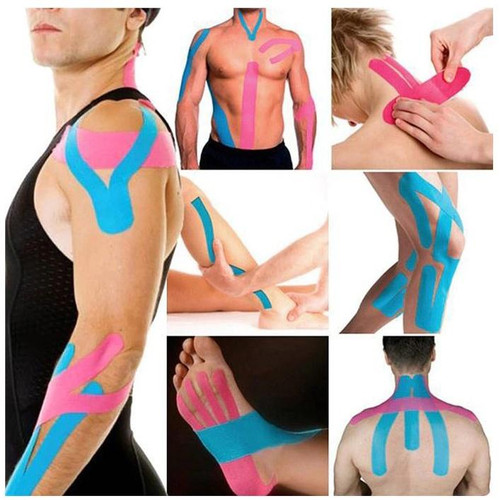Do you ever watch a professional tennis game or competitive bike race and wonder what the colourful strips of tape athletes wear is? Well, the answer is Kinesiology Tape. Kinesiology tape (or KT tape) is a therapeutic tape, which we apply strategically to the body to help reduce swelling, provide support, decrease pain and improve performance.
Kinesiology tape mimics the skins elasticity. Thus, the tape is a lot more stretchy than your standard rigid sports tape, and is designed to allow you to maintain full range of motion, however still providing support.
Most types of strapping tape are non-elastic and are wrapped firmly around an injured joint to provide rigid support and restrict movement. Conversely, kinesiology tape differs by it’s unique elastic properties. As a result, this allows the tape to provide dynamic support and you can wear it during intense exercise to help guide your movement.

How does Kinesiology tape work?
1. Pain relief.
Kinesiology tape’s lifting action may relieve pressure on pain receptors under the skin. Furthermore, this change in pressure changes the information your sensory nervous system is sending about pain and compression in your body.
All of our body tissues (including skin, muscles, connective tissue) contain sensory receptors that feel pain, temperature, and touch. The sensation of tape helps trick your body into an alternative stimulus, so your brain concentrates on this new sensation rather than the pain receptor feedback.
2. Helps provide proprioceptive feedback.
The sensory receptors mentioned above also contribute to proprioception, your brain’s sense of where your body is in space. Kinesiology taping creates a lift that unloads the underlying tissues. Subsequently, by decompressing these tissues we change the signals going to the brain.
3. May help reduce swelling.
If you’ve been injured, kinesiology tape may help improve circulation and reduce swelling in the injured area. Furthermore, it is believed kinesiology taping can improve blood flow in the skin and improve circulation of lymphatic fluids.
By lifting this skin, kinesiology tape creates extra subcutaneous space and provides a negative pressure under the tape. This change in the pressure gradient in the area underneath your skin enhances the flow of lymphatic fluid. This in turn may help drain swelling and other inflammatory cells away from the injured area.
4. Supporting weak muscles and joints.
Kinesiology tape is also used to add extra support to muscles or joints that need it.
Unlike rigid sports tape, kinesiology tape lets you move normally. However, it can help support muscles that are fatigued or weaker, while you work on strengthening as part of your rehabilitation plan. We use tape to correct posture or retrain biomechanical patterns. The sensation of tape on your skin can make you more aware of how you’re standing or moving.
In addition to the benefits listed, by supporting weak or painful body parts, kinesiology tape may allow injured athletes to return to sport quicker than without dynamic support.

When not to use tape:
There are some circumstances in which kinesiology tape should not be used. They include the following.
Open wounds. Using tape over a wound could lead to infection or skin damage.
Allergy. If your skin is sensitive to adhesives, you could trigger a strong reaction.
Fragile skin. If your skin is prone to tearing, you should avoid placing tape on it.
If you would like to know more about the use of Kinesiology tape for your injury, your physiotherapist will be able to provide you with more information and discuss if it is suitable for you.
Sheree

